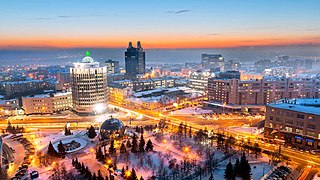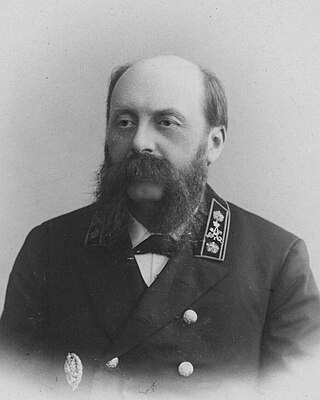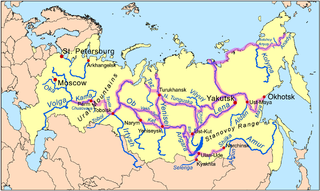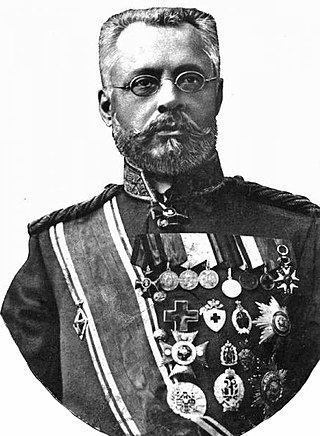
The Russian Revolution of 1905, also known as the First Russian Revolution, began on 22 January 1905. A wave of mass political and social unrest then began to spread across the vast areas of the Russian Empire. The unrest was directed primarily against the Tsar, the nobility, and the ruling class. It included worker strikes, peasant unrest, and military mutinies. In response to the public pressure, Tsar Nicholas II was forced to go back on his earlier authoritarian stance and enact some reform. This took the form of establishing the State Duma, the multi-party system, and the Russian Constitution of 1906. Despite popular participation in the Duma, the parliament was unable to issue laws of its own, and frequently came into conflict with Nicholas. The Duma's power was limited and Nicholas continued to hold the ruling authority. Furthermore, he could dissolve the Duma, which he did three times in order to get rid of the opposition.

Irkutsk is the largest city and administrative center of Irkutsk Oblast, Russia. With a population of 617,473 as of the 2010 Census, Irkutsk is the 25th-largest city in Russia by population, the fifth-largest in the Siberian Federal District, and one of the largest cities in Siberia.

The Trans-Siberian Railway, historically known as the Great Siberian Route and often shortened to Transsib, is a large railway system that connects European Russia to the Russian Far East. Spanning a length of over 9,289 kilometers, it is the longest railway line in the world. It runs from the city of Moscow in the west to the city of Vladivostok in the east.

Novosibirsk is the largest city and administrative centre of Novosibirsk Oblast and the Siberian Federal District in Russia. As of the 2021 Census, it had a population of 1,633,595, making it the most populous city in Siberia and the third-most populous city in Russia after Moscow and Saint Petersburg. The city is located in southwestern Siberia, on the banks of the Ob River.

Tomsk is a city and the administrative center of Tomsk Oblast in Russia, located on the Tom River. Population: 556,478 (2021 Census); 524,669 (2010 Census); 487,838 (2002 Census); 501,963 (1989 Census).

Irkutsk Oblast is a federal subject of Russia, located in southeastern Siberia in the basins of the Angara, Lena, and Nizhnyaya Tunguska Rivers. The administrative center is the city of Irkutsk. It borders the Republic of Buryatia and the Tuva Republic in the south and southwest, which separate it from Khövsgöl Province in Mongolia; Krasnoyarsk Krai in the west; the Sakha Republic in the northeast; and Zabaykalsky Krai in the east. It had a population of 2,370,102 at the 2021 Census.

The early history of Siberia was greatly influenced by the sophisticated nomadic civilizations of the Scythians (Pazyryk) on the west of the Ural Mountains and Xiongnu (Noin-Ula) on the east of the Urals, both flourishing before the common era. The steppes of Siberia were occupied by a succession of nomadic peoples, including the Khitan people, various Turkic peoples, and the Mongol Empire. In the Late Middle Ages, Tibetan Buddhism spread into the areas south of Lake Baikal.

The Eurasian Land Bridge, sometimes called the New Silk Road, is the rail transport route for moving freight and passengers overland between Pacific seaports in the Russian Far East and China and seaports in Europe. The route, a transcontinental railroad and rail land bridge, currently comprises the Trans-Siberian Railway, which runs through Russia and is sometimes called the Northern East-West Corridor, and the New Eurasian Land Bridge or Second Eurasian Continental Bridge, running through China and Kazakhstan. As of November 2007, about one percent of the $600 billion in goods shipped from Asia to Europe each year were delivered by inland transport routes.

Lavr Dmitrievich Proskouriakov was one of the foremost authorities on bridge engineering and structural mechanics in the Russian empire and the early Soviet Union.

National Research Tomsk Polytechnic University (TPU) is a technical university in Russia. TPU was a member of 12 international associations, including the Conference of European Schools for Advanced Engineering Education and Research (CESAER) until it was suspended in March 2022, and the European University Association (EUA) until it was suspended in March 2022. TPU was included in Project 5-100, a 2013 state program aimed at bringing at least five Russian universities from among the project participants into the 100 best universities in the world.

Nikolai Apollonovich Belelubsky was a distinguished Russian academic specialising in railway and civil engineering. Over the course of his life he became a member of many learned societies and the author of many papers and lectures.

Moscow Yaroslavsky railway station is one of the nine main railway stations in Moscow. Situated on Komsomolskaya Square, Moscow Yaroslavskaya has the highest passenger throughput of all nine of the capital's main-line terminuses. It serves eastern destinations, including those in the Russian Far East, being the western terminus of the world's longest railway line, the Trans-Siberian. The station takes its name from that of the ancient city of Yaroslavl which, lying 284 rail kilometres north-east of Moscow, is the first large city served by the line.

The Chita Republic was a short-lived workers' republic based in Chita around the turn of the year 1905/1906. Chita, a city in eastern Siberia, Russia, and a place of exile for early revolutionaries and combatants of the Russo-Japanese War, was a center for worker unrest in the early 1900s. During the Russian Revolution of 1905 armed revolutionaries under the leadership of the RSDLP headed by Viktor Kurnatovsky, Anton Kostiushko-Voliuzhanich, and Ivan Babushkin organized themselves into a "Soviet of Soldiers' and Cossacks' Deputies" and took control over the city, declaring the Chita Republic in December 1905.

The Gubkin Russian State University of Oil and Gas is a public university in Moscow, Russia. The university was founded in 1930 and is named after the geologist Ivan Gubkin. The university is colloquially known as Kerosinka, meaning 'kerosene stove'.

Siberian River Routes were the main ways of communication in Russian Siberia before the 1730s, when roads began to be built. The rivers were also of primary importance in the process of Russian conquest and exploration of vast Siberian territories eastwards. Since the three great Siberian rivers, the Ob, the Yenisey, and the Lena all flow into the Arctic Ocean, the aim was to find parts or branches of these rivers that flow approximately east-west and find short portages between them. Since Siberia is relatively flat, portages were usually short. Despite resistance from the Siberian tribes, Russian Cossacks were able to expand from the Urals to the Pacific in only 57 years (1582-1639). These river routes were crucial in the first years of the Siberian fur trade as the furs were easier to transport over water than land. The rivers connected the major fur gathering centers and provided for relatively quick transport between them.

Tourism in Mongolia was extremely limited by the Socialist Government, but has been expanding following the 1990 Democratic Revolution in Mongolia in the wake of the collapse of the USSR and the Revolutions of 1989. Mongolia is a unique and relatively unexplored travel destination that offers a great combination of scenic natural features, a wide variety of untouched landscapes, nomadic life style and culture. Travel organizations in Mongolia date back to half a century ago, but the private sector-based tourism is barely twenty years old. Now Mongolia boasts 403 travel companies, 320 hotels, 647 resorts and tourist camps, all employing the graduates from over 56 educational establishments. Mongolia takes an active part in United Nations World Tourism Organization, of which it is a member party.

Russia was and is the largest country in the world. Its geography of north–south rivers and east–west commerce, plus, importantly, the mostly flat terrain, made it very suited to develop railroads as the basic mode of transportation.
Battle of Barnaul was a series of conflicts during the Russian Civil War from June 13–15, 1918, involving different factions in the Siberian region. The Red Guards and the White movement were the main combatants.

The Republic of Buryatia is a federal subject of Russia which, according to the IMF, was an emerging economy in 2011.

Nikolay Lvovich Gondatti was a Russian statesman, a researcher of Northern and Northeastern Siberia. Stallmeister of the Court of His Imperial Majesty Nicholas II, Active State Councillor. A member of many Russian scientific societies.



















